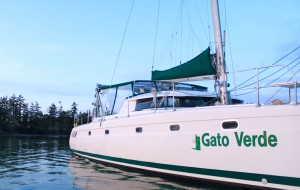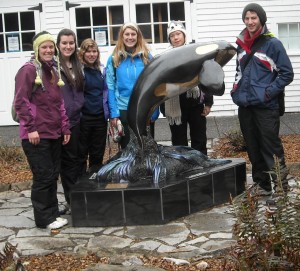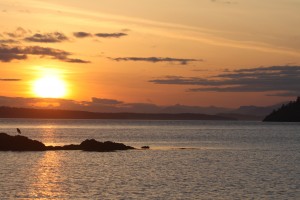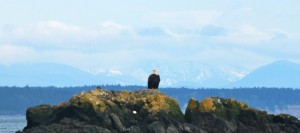Life aboard the Gato Verde
We did it! Beam Reach Class 121 survived almost four full weeks living aboard a catamaran, studying physical oceanography, underwater sounds, and the Southern Resident Killer Whales, and most importantly we did it together.
Our experience wasn’t just any regular research field experience. We were lucky enough to live aboard the Gato Verde, a glorious 42’ catamaran developed to be “Boat Greenâ€. Not only was our living experience pretty plush for field researchers, but we also learned how to live sustainably on the water while conducting our own individual research projects.
Although designing and conducting my own research project was academically challenging, living and working on the Gato proved to be a whole different kind of challenge. I learned to be very conscious of my own space and personal needs in a group dynamic, which I feel is one of the most valuable lessons I learned aboard the Gato. I also became very conscious of other things during our time at sea: my waste output as well as my classmate waste output; the state of the currents and tides at any given moment, our time on the water each and every day, and where all the good mooring spots are near Haro Strait. We monitored these various factors as well as other important boat factors every day before we planned our science activities during the daily morning meetings.
Monitoring Our Impacts
Each day we were assigned different duties in terms of boat maintenance and preparation for the day ahead. The student assigned to “systems†each day was required to monitor the battery and biodiesel usage of the Gato as well as our water and sewage levels. These four things are all very important to keep track of to keep the Gato running efficiently and also to be aware of our environmental impact. Sewage, also known as “black water†is a huge environmental concern for oceanic boaters. We monitor our sewage levels daily to ensure that we never run out of room in our holding tank. Anaerobic bacteria dominate our black water system and it is vital to make sure we do not run into a scenario where we dump this black water into the oceanic environment.
Part of living and, pooping, aboard a boat also means that you have to get all of the poop off of the boat, unless you want it to continue living with you, which wouldn’t be a pleasant experience for anyone. We were lucky enough to be able to “pump out†our sewage system three different times! When pumping out we usually had two students helping. A big hose with a suction cup at the end of it was attached to our sewage tank and then magic happens! Our waste, which now looks like brown, muddy water, begins to pump through this hose off of our boat. Although it sounds somewhat repulsive, it is actually kind of interesting. To make it easier on the students who were pumping out each time, we all took turns purchasing ice cream to share at the convenience store. Turns out that a little bit of ice cream made pumping out a favorite activity of Beam Reach class 121!
To decrease our sewage output aboard the Gato, we attempted to use “shore headsâ€, or toilets on land, whenever they were available. This meant if we pulled up to a mooring site and there was dock space available, we always went for the dock space, just because we could use the shore heads instead of the heads aboard the Gato, which means more time between pump outs!
Moving with the Wind
We had at least a week of beautiful, warm, and sunny weather during our time on Gato, which we took full advantage of by swimming in the Salish Sea multiple times! However, the wind wasn’t always on our side which prevented us from doing a whole lot of sailing this spring. During our 4-day cruise up to Cherry Point Captain Todd wanted to teach us how to tack. Of course we were all thrilled to sail, and move efficiently on the water using the wind. Tacking, also known, as “coming about†is a pretty common sailing technique that utilizes the wind by essentially sailing into the wind. The bow of the boat is directed through the wind, allowing the boat to change the direction that the wind blows into the boat. We learned how to tack on both the port and starboard sides of the boat. Tacking is one of my favorite sailing techniques that we learned because it really allowed us to actively take part in the sailing.
Helmsman
Sitting at the helm of the Gato was one of my favorite places to be, not only because it kept me from being sea sick all of the time, but also because I just love to drive boats. Manning the helm of the Gato was a really interesting experience, unlike driving any other boat. Being given the option of manually steering or using the autopilot function, I most always chose manual steering. It is a powerful feeling to be in charge of the direction of such a big vessel.
The End of the Voyage
As we pulled into Friday Harbor Labs for the last time, I felt an indescribable amount of emotions. I was relieved to have civilization, showers, Internet, warm food, all at my easy access, but somehow in such a short period of time I had grown accustom to life on the Gato. The small things that had at first posed challenges, such as waking up early, entering data on the boat, checking the navigational charts every hour, now felt apart of my every day life. The dock drew nearer as we were attaching the buoys to the boat with clove hitches, one last time. Once we were at the docks, we did a final set of bow and stern cleat hitches and began disembarking all of our personal and science gear. It was a bittersweet process, but rewarding on so many levels.
Wrapping up…
The most difficult aspect of the Beam Reach program was learning to live with so many people in such a small and mobile space like the Gato Verde. Yet, it proved to be one of the most rewarding experiences of my academic career. Saying good by my instructors and fellow students has actually been harder than the course itself and I know that no matter what else has come of this program, I have gained an extended family of sorts…I will miss them all, and our home on the water, dearly this summer.
Read More





 Twitter
Twitter LinkedIn
LinkedIn Facebook
Facebook